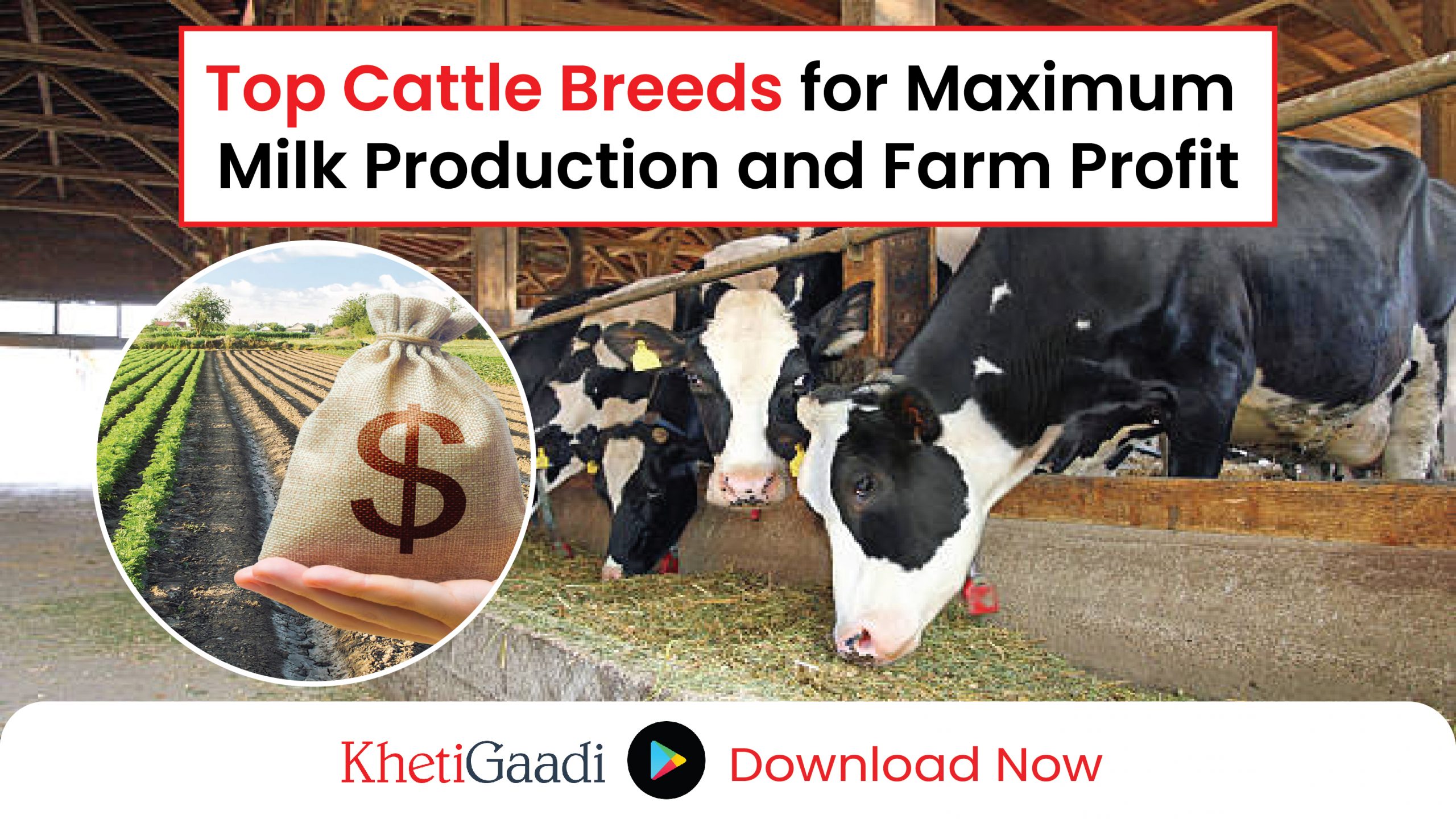Top Cattle Breeds to Maximize Profits
India is one of the largest milk producers in the world, thanks to its diverse range of cattle breeds that are well-adapted to various climatic conditions. For dairy farmers, choosing the right cattle breed is crucial for maximizing milk production and ensuring profitability. This blog explores the top cattle breeds in India known for their high milk production, detailing their yield, annual expenses, and the scope of the dairy milk production business. By understanding these factors, farmers can make informed decisions to enhance their dairy operations.
1. Sahiwal
Overview: Sahiwal cattle are one of the best dairy breeds in India, originating from the Sahiwal district of Punjab. Known for their high milk yield and adaptability to tropical climates, Sahiwal cows are a favourite among dairy farmers.
- Average Yield: 3,000 to 4,000 litres per lactation period (approximately 305 days).
- Daily Yield: 10-15 litres per day.
Annual Expenses:
- Feed and Nutrition: ₹20,000 – ₹30,000 per cow.
- Healthcare: ₹5,000 – ₹7,000 per cow.
- Miscellaneous (housing, labour, etc.): ₹3,000 – ₹5,000 per cow.
- Total Annual Expenses: ₹28,000 – ₹42,000 per cow.
Scope in Dairy Milk Production Business: Sahiwal cattle are highly valued for their resilience and milk quality. Their ability to thrive in both intensive and extensive farming systems makes them versatile for various dairy business models. With increasing demand for high-quality milk, Sahiwal cows present a profitable investment for dairy farmers.
2. Jersey
Overview: Originating from the Channel Islands, Jersey cattle have been successfully introduced in India. They are renowned for their high butterfat content in milk, making their milk ideal for producing premium dairy products.
- Average Yield: 4,000 to 5,000 litres per lactation period.
- Daily Yield: 15-20 litres per day.
Annual Expenses:
- Feed and Nutrition: ₹25,000 – ₹35,000 per cow.
- Healthcare: ₹6,000 – ₹8,000 per cow.
- Miscellaneous: ₹4,000 – ₹6,000 per cow.
- Total Annual Expenses: ₹35,000 – ₹49,000 per cow.
Scope in Dairy Milk Production Business: Jersey cows are preferred for their rich milk, which commands higher prices in the market. Their smaller size and efficient feed conversion make them suitable for farmers with limited space and resources. The high demand for value-added dairy products like cheese and butter further enhances the profitability of keeping Jersey cattle.
3. Holstein Friesian (HF)
Overview: Holstein Friesian (HF) cattle are the highest milk-producing breed globally. Introduced in India, they have gained popularity among large-scale dairy farms due to their superior milk yield.
Milk Production:
- Average Yield: 5,000 to 7,000 litres per lactation period.
- Daily Yield: 20-25 litres per day.
Annual Expenses:
- Feed and Nutrition: ₹30,000 – ₹40,000 per cow.
- Healthcare: ₹7,000 – ₹10,000 per cow.
- Miscellaneous: ₹5,000 – ₹7,000 per cow.
- Total Annual Expenses: ₹42,000 – ₹57,000 per cow.
Scope in Dairy Milk Production Business: HF cows are ideal for intensive dairy farming due to their exceptional milk production capabilities. They require well-managed feeding and healthcare systems but offer significant returns through high-volume milk sales. Their adaptability to different farming practices makes them a valuable asset for modern dairy businesses.
4. Gir
Overview: Gir cattle originate from the Gir Forest region of Gujarat and are celebrated for their high milk yield and adaptability to hot climates. They are an integral part of India’s dairy heritage.
Milk Production:
- Average Yield: 2,500 to 3,500 litres per lactation period.
- Daily Yield: 8-12 litres per day.
Annual Expenses:
- Feed and Nutrition: ₹18,000 – ₹25,000 per cow.
- Healthcare: ₹4,000 – ₹6,000 per cow.
- Miscellaneous: ₹2,500 – ₹4,000 per cow.
- Total Annual Expenses: ₹24,500 – ₹35,000 per cow.
Scope in Dairy Milk Production Business: Gir cows are known for their hardiness and ability to thrive in challenging environments. Their milk is highly nutritious, making them suitable for producing a variety of dairy products. With increasing consumer preference for organic and traditional dairy products, Gir cattle offer a niche market for dairy farmers.
5. Red Sindhi
Overview: Red Sindhi cattle are native to the Sindh region and have been extensively bred in India for their milk-producing capabilities. They are well-suited to hot and humid climates, making them ideal for many parts of India.
Milk Production:
- Average Yield: 2,500 to 3,500 litres per lactation period.
- Daily Yield: 8-12 litres per day.
Annual Expenses:
- Feed and Nutrition: ₹20,000 – ₹28,000 per cow.
- Healthcare: ₹5,000 – ₹7,000 per cow.
- Miscellaneous: ₹3,000 – ₹5,000 per cow.
- Total Annual Expenses: ₹28,000 – ₹40,000 per cow.
Scope in Dairy Milk Production Business: Red Sindhi cows are prized for their calm temperament and ease of handling, which is beneficial for small to medium-sized dairy farms. Their efficient feed conversion and high adaptability make them a reliable choice for consistent milk production. Additionally, their ability to graze on rough pastures reduces feed costs, enhancing profitability.
6. Karan Swiss
Overview: Karan Swiss is a relatively new breed in India, developed through crossbreeding indigenous cows with Swiss breeds. This breed combines the hardiness of local breeds with the high milk production of European cattle.
Milk Production:
- Average Yield: 3,500 to 4,500 litres per lactation period.
- Daily Yield: 12-15 litres per day.
Annual Expenses:
- Feed and Nutrition: ₹22,000 – ₹30,000 per cow.
- Healthcare: ₹6,000 – ₹8,000 per cow.
- Miscellaneous: ₹3,500 – ₹5,500 per cow.
- Total Annual Expenses: ₹31,500 – ₹43,500 per cow.
Scope in Dairy Milk Production Business: Karan Swiss cows offer a balanced combination of high milk yield and resilience, making them suitable for various farming systems. Their improved genetic traits result in better milk quality and higher fat content, catering to the premium dairy market. As awareness grows, Karan Swiss is gaining traction among progressive dairy farmers in India.
7. Tharparkar
Overview: Tharparkar cattle hail from the Thar Desert region and are known for their ability to withstand extreme temperatures and scarce water resources. They are dual-purpose cattle, used for both milk and draft purposes.
Milk Production:
- Average Yield: 2,000 to 3,000 litres per lactation period.
- Daily Yield: 6-10 litres per day.
Annual Expenses:
- Feed and Nutrition: ₹18,000 – ₹25,000 per cow.
- Healthcare: ₹4,000 – ₹6,000 per cow.
- Miscellaneous: ₹2,500 – ₹4,500 per cow.
- Total Annual Expenses: ₹24,500 – ₹35,500 per cow.
Scope in Dairy Milk Production Business: Tharparkar cattle are ideal for regions with harsh climatic conditions. Their ability to produce milk with minimal resources makes them a sustainable choice for farmers in arid areas. Additionally, their dual-purpose nature allows farmers to utilize them for both dairy and agricultural work, maximizing the utility of each animal.
Annual Expenses Comparison
To provide a clearer picture, here’s a comparative table of annual expenses for the top cattle breeds:
| Breed | Feed & Nutrition (₹) | Healthcare (₹) | Miscellaneous (₹) | Total Annual Expenses (₹) |
| Sahiwal | 20,000 – 30,000 | 5,000 – 7,000 | 3,000 – 5,000 | 28,000 – 42,000 |
| Jersey | 25,000 – 35,000 | 6,000 – 8,000 | 4,000 – 6,000 | 35,000 – 49,000 |
| Holstein Friesian | 30,000 – 40,000 | 7,000 – 10,000 | 5,000 – 7,000 | 42,000 – 57,000 |
| Gir | 18,000 – 25,000 | 4,000 – 6,000 | 2,500 – 4,000 | 24,500 – 35,000 |
| Red Sindhi | 20,000 – 28,000 | 5,000 – 7,000 | 3,000 – 5,000 | 28,000 – 40,000 |
| Karan Swiss | 22,000 – 30,000 | 6,000 – 8,000 | 3,500 – 5,500 | 31,500 – 43,500 |
| Tharparkar | 18,000 – 25,000 | 4,000 – 6,000 | 2,500 – 4,500 | 24,500 – 35,500 |
Scope in Cattle Milk Production Business
The dairy industry in India presents immense opportunities for growth and profitability. With increasing demand for milk and dairy products driven by population growth and rising income levels, investing in high-yield cattle breeds can yield substantial returns. Here’s why the scope is promising:
- Growing Domestic Demand:
The demand for milk and dairy products in India continues to rise, with per capita consumption increasing year by year. This growth is fuelled by the expanding middle class and changing dietary preferences.
- Government Support:
The Indian government offers various subsidies and schemes to support dairy farmers, including the National Dairy Plan and Rashtriya Gokul Mission. These initiatives aim to enhance milk production and improve the livelihoods of dairy farmers.
- Technological Advancements:
Innovations in dairy farming technology, such as automated milking systems and improved breeding techniques, are increasing milk yields and operational efficiency.
- Value-Added Products:
There is a growing market for value-added dairy products like cheese, yogurt, and ghee, which offer higher profit margins compared to raw milk.
- Export Opportunities:
India has a significant potential for exporting dairy products, tapping into international markets that demand high-quality milk and dairy goods.
- Sustainable Practices:
Emphasis on sustainable and organic farming practices is attracting consumers who prefer ethically produced dairy products, providing a niche market for premium breeds.
Choosing the Right Breed for Your Farm
Selecting the appropriate cattle breed depends on various factors, including climate, available resources, and specific business goals. Here are some considerations to help you make an informed decision:
- Climate Adaptability:
Choose a breed that is well-suited to your region’s climate. For instance, Sahiwal and Gir are ideal for hot and humid areas, while Holstein Friesian thrives in cooler climates.
- Milk Yield vs. Maintenance Cost:
High-yield breeds like Holstein Friesian require more investment in feed and healthcare but offer greater returns through increased milk production. Evaluate your budget and capacity to manage these costs.
- Market Demand:
Understand the preferences of your target market. If there is a demand for high-fat milk for butter and cheese production, Jersey and Karan Swiss may be more profitable.
- Farm Size and Infrastructure:
Large breeds like Holstein Friesian require more space and better infrastructure, whereas smaller breeds like Red Sindhi and Tharparkar are suitable for smaller farms.
- Breeding and Genetics:
Invest in breeds with good genetic potential for milk production. Crossbreeding can also be considered to combine the strengths of different breeds.
Conclusion
Choosing the right cattle breed is a foundational step toward building a successful dairy farm in India. Each of the top cattle breeds discussed—Sahiwal, Jersey, Holstein Friesian, Gir, Red Sindhi, Karan Swiss, and Tharparkar—offers unique advantages in terms of milk production, adaptability, and profitability. By carefully evaluating your farm’s specific needs and aligning them with the strengths of these breeds, you can optimize milk yields and ensure a profitable dairy business.
Moreover, leveraging government schemes, adopting modern dairy farming practices, and exploring value-added dairy products can further enhance your farm’s profitability. As the demand for milk and dairy products continues to grow, investing in high-yield cattle breeds is a strategic move that promises substantial returns and contributes to the thriving Indian dairy industry.
Reference Links
Department of Animal Husbandry
Vermiculture and Dairy Farming
Tags
#CattleBreedsIndia, #HighMilkProduction, #DairyFarming, #IndianCattleBreeds, #SahiwalCattle




